If Oil Prices Go Up Again How Might Your Life Have to Change
What a daunting question! With oil prices increasing rapidly in the recent past, it is hard not to wonder what has caused it and just what effect it might have on the rest of the economy. Let me begin by discussing the evolution of oil prices over time.
How have oil prices behaved in recent decades?
Figure 1 shows the history of the price of oil since the early 1950s. The price shown is the monthly average spot price of a barrel of West Texas intermediate crude oil, measured in U.S. dollars. The gray bars in this and all the following figures represent recessions, as defined by the National Bureau of Economic Research.
Figure 1. Spot Oil Price ($ Barrel)

As you can see from Figure 1, a long period of oil price stability was interrupted in 1973. In fact, the 1970s show two distinct jumps in oil prices: one was triggered by the Yom Kippur War in 1973, and one was prompted by the Iranian Revolution of 1979. Since then, oil prices have regularly displayed volatility relative to the '50s and '60s.
Figure 2 shows the "real" oil price, calculated by dividing the price of oil by the GDP deflator. 1 This removes the effect of inflation and thus gives a more accurate sense of what is happening to the price of the commodity itself. In essence, the "real" measure allows you to compare oil prices over time in a way that you can't when inflation is also part of the change in price. You can see that real oil prices have varied a lot over time, and large fluctuations tend to be concentrated over somewhat short periods. You can also see that by the spring of 2008, as this posting was prepared, the real price of oil has easily exceeded that of the late 1970s.
Figure 2. Real Oil Price
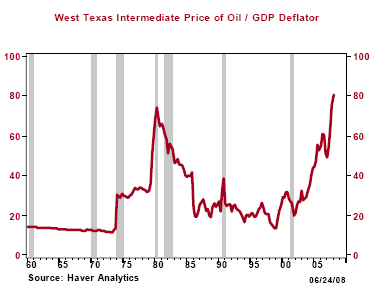
Why are oil prices rising?
It is likely that both increases in demand and fears of supply disruptions have exerted upward pressure on oil prices.2 Global demand for oil has been increasing, outpacing any gains in oil production and excess capacity. A large reason is that developing nations, especially China and India, have been growing rapidly. These economies have become increasingly industrialized and urbanized, which has contributed to an increase in the world demand for oil. In addition, in recent years fears of supply disruptions have been spurred by turmoil in oil-producing countries such as Nigeria, Venezuela, Iraq, and Iran (Brown 2006).
The breathtakingly sharp increase in the price of oil in the last half of 2007 and first half of 2008 has led many to argue that increased speculation in commodity markets has played a role, and indeed there is evidence of increased activity in these markets. However, whether speculation is playing a role in high oil prices is open to debate (Krugman 2008). It is also useful to remember that both the demand for and the supply of oil react sluggishly to changes in prices in the short run, so very large changes in prices can be required to restore equilibrium if demand should move even modestly out of line with supply.
As far as the implications of higher oil prices, there are both microeconomic and macroeconomic answers to that question. I will address both of these aspects in turn.
How do high oil prices affect the economy on a "micro" level?
As a consumer, you may already understand the microeconomic implications of higher oil prices. When observing higher oil prices, most of us are likely to think about the price of gasoline as well, since gasoline purchases are necessary for most households. When gasoline prices increase, a larger share of households' budgets is likely to be spent on it, which leaves less to spend on other goods and services. The same goes for businesses whose goods must be shipped from place to place or that use fuel as a major input (such as the airline industry). Higher oil prices tend to make production more expensive for businesses, just as they make it more expensive for households to do the things they normally do.
It turns out that oil and gasoline prices are indeed very closely related. Figure 3 plots average monthly oil prices from 1990 through early 2008, using the spot oil price for West Texas intermediate (right scale, thin blue line, measured in dollars per barrel) and the U.S. retail gasoline price (left scale, thick red line, measured in cents per gallon). The two series track each other very closely over time: increases in oil prices are accompanied by increases in gasoline prices. As shown in the graph, the correlation coefficient (denoted "r") for the two series is 0.98. Moreover, the monthly changes in oil prices and gasoline prices (not shown) also are very highly and positively correlated.
Figure 3. U.S. Gasoline and Oil Prices
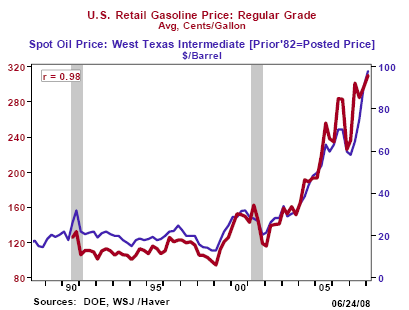
So, when oil prices spike, you can expect gasoline prices to spike as well, and that affects the costs faced by the vast majority of households and businesses.
What effects do oil prices have on the "macro" economy?
I've just explained how oil prices affect households and businesses; it is not a far leap to understand how oil prices affect the macroeconomy. Oil price increases are generally thought to increase inflation and reduce economic growth. In terms of inflation, oil prices directly affect the prices of goods made with petroleum products. As mentioned above, oil prices indirectly affect costs such as transportation, manufacturing, and heating. The increase in these costs can in turn affect the prices of a variety of goods and services, as producers may pass production costs on to consumers. The extent to which oil price increases lead to consumption price increases depends on how important oil is for the production of a given type of good or service.
Oil price increases can also stifle the growth of the economy through their effect on the supply and demand for goods other than oil. Increases in oil prices can depress the supply of other goods because they increase the costs of producing them. In economics terminology, high oil prices can shift up the supply curve for the goods and services for which oil is an input.
High oil prices also can reduce demand for other goods because they reduce wealth, as well as induce uncertainty about the future (Sill 2007). One way to analyze the effects of higher oil prices is to think about the higher prices as a tax on consumers (Fernald and Trehan 2005). The simplest example occurs in the case of imported oil. The extra payment that U.S. consumers make to foreign oil producers can now no longer be spent on other kinds of consumption goods.3
Despite these effects on supply and demand, the correlation between oil price increases and economic downturns in the U.S. is not perfect. Not every sizeable oil price increase has been followed by a recession. However, five of the last seven U.S. recessions were preceded by considerable increases in oil prices (Sill 2007).4
Is the relationship between oil prices and the economy always the same?
The two aforementioned large oil shocks of the 1970s were characterized by low growth, high unemployment, and high inflation (also often referred to as periods of stagflation). It is no wonder that changes in oil prices have been viewed as an important source of economic fluctuations.
However, in the past decade research has challenged this conventional wisdom about the relationship between oil prices and the economy. As Blanchard and Gali (2007) note, the late 1990s and early 2000s were periods of large oil price fluctuations, which were comparable in magnitude to the oil shocks of the 1970s. However, these later oil shocks did not cause considerable fluctuations in inflation (Figure 4), real GDP growth (Figure 5), or the unemployment rate.
Figure 4. Oil Prices and CPI Inflation
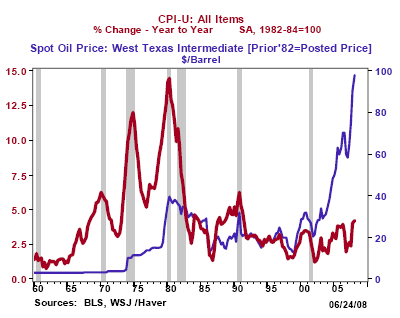
Figure 5. Oil Prices and Real GDP Growth
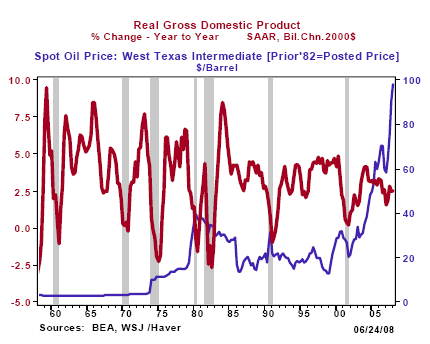
A caveat is in order, however, because simply observing the movements of inflation and growth around oil shocks may be misleading. Keep in mind that oil shocks have often coincided with other economic shocks. In the 1970s, there were large increases in commodity prices, which intensified the effects on inflation and growth. On the other hand, the early 2000s were a period of high productivity growth, which offset the effect of oil prices on inflation and growth. Therefore, to determine whether the relationship between oil prices and other variables has truly changed over time, one must go beyond casual observations and appeal to econometric analysis (which allows researchers to control for other developments in the economy when studying the link between oil prices and key macroeconomic variables).
Formal studies find evidence that the link between oil prices and the macroeconomy has indeed deteriorated over time. For example, Hooker (2002) suggests that the structural break in the relationship between inflation and oil prices occurred at the end of 1980s. Blanchard and Gali (2007) look at the responses of prices, wage inflation, output, and employment to oil shocks. They too find that the responses of all these variables to oil shocks have become muted since the mid-1980s.
Why might the relationship between oil prices and key macroeconomic variables have weakened?
Economists have offered some potential explanations behind the weakening link between oil prices and inflation. Gregory Mankiw (2007) suggests increases in energy efficiency as one explanation. Indeed, as shown in Figure 6, energy consumption per dollar of GDP has gone down steadily over time. This means that energy prices matter less today than they did in the past. Blanchard and Gali (2007) suggest additional explanations. They find that increased flexibility in labor markets, monetary policy improvements, and a bit of good luck (meaning the lack of concurrent adverse shocks) have also contributed to the decline of the impact of oil shocks on the economy.
Finally, how monetary policymakers treated the economic shocks caused by rising oil prices also may have played a role in the impact of the shocks on economic growth and the inflation rate. Specifically, some have argued policymakers tended to worry more about output than inflation during the oil shocks of 1970s and did not adequately take into account the inflationary aspect of the oil shocks when fashioning a policy response to them (see, for example, Clarida, Gali, and Gertler 2000). In the case of the U.S., since households and firms sensed that the Fed was not going to pay a lot of attention to inflation, they probably realized that the oil shocks would lead to substantially higher future inflation and adjusted their expectations accordingly. By contrast, the Fed in the 2000s is more committed to fighting inflation, the public knows it, and the result has been that, even though headline inflation has risen noticeably because of the direct effects of oil and commodity shocks, core inflation and inflation expectations remain contained.
The lack of major output effects of oil price shocks since the 1970s calls into question what role they played during the two recessions of that period. In other words, one possible reason why oil shocks seem to have noticeably smaller effects on output now than they did in the 1970s is that the world has changed. Another is that the effects of oil shocks were never as large as conventional wisdom hold, and that the slow growth of that decade had to do with other factors.
Figure 6. U.S. Energy Consumption
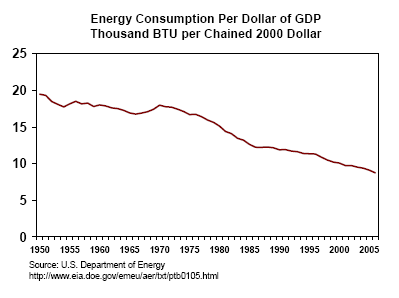
Endnotes
1. Note that there are many possible ways to measure real oil prices, depending on which measure of inflation you use.
2. To read more about supply and demand pressures on the world market for oil, consult the Short-Term Energy Outlook provided by the U.S. Energy Information Administration.
3. Trade does complicate matters here, because some of the U.S. consumption expenditures would have been made on imports, so that doesn't affect the domestic economy. Second, oil producers will use some of their income to buy goods from the U.S., so that income is not lost to the U.S. Even so, there is a loss here, because they can buy more U.S. exports for each barrel of oil.
4. At the time this response was written, the NBER had not made an official pronouncement on whether the economy had entered a recession in early 2008.
References
Blanchard, Olivier, and Jordi Gali. 2007. "The Macroeconomic Effects of Oil Shocks: Why Are the 2000s So Different from 1970s." NBER Working Paper No. 13368.
Fernald, John, and Bharat Trehan. 2005. "Why Hasn't the Jump in Oil Prices Led to a Recession?" FRBSF Economic Letter 2005-31.
Hooker, Mark. 2002. "Are Oil Shocks Inflationary? Asymmetric and Nonlinear Specifications versus Changes in Regime." Journal of Money Credit and Banking, Vol. 34, Issue 2, pp. 540-561.
Krugman, Paul. 2008. "Fuels on the Hill." New York Times, June 27, 2008.
Mankiw, Gregory. 2007. "Where Have All the Oil Shocks Gone?"
Sill, Keith. 2007. "The Macroeconomics of Oil Shocks."
FRB Philadelphia Business Review, 2007:Q1.
casarezoutworight.blogspot.com
Source: https://www.frbsf.org/education/publications/doctor-econ/2007/november/oil-prices-impact-economy/
0 Response to "If Oil Prices Go Up Again How Might Your Life Have to Change"
Enregistrer un commentaire